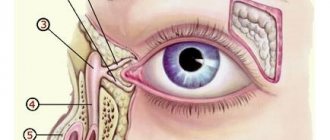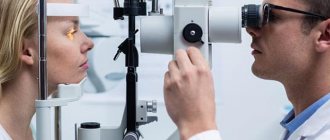The lacrimal organs are a system of the appendage apparatus of the eye that protects the eyes from drying out, produces tear fluid and drains it into the nasal cavity.
Lacrimal organs are divided into tear-producing ( tear-secretory ) and lacrimal-draining organs .
The tear duct consists of the main lacrimal gland and several additional ones located in the conjunctival sac.
The lacrimal ducts include: lacrimal openings, lacrimal lake, lacrimal stream and other formations along which tears move before entering the nasal cavity.
1
Diseases of the lacrimal organs. Diagnosis and treatment
2 Diseases of the lacrimal organs. Diagnosis and treatment
3 Diseases of the lacrimal organs. Diagnosis and treatment
The structure of the lacrimal gland
The gland that synthesizes tear fluid consists of two parts: lower (palpebral, orbital) and upper (orbital, secular). These parts are separated by a muscular tendon responsible for raising the upper eyelid.
The orbital part is located in the upper outer region of the orbit. 3-5 excretory tubules emerge from it, flowing into the upper fornix of the conjunctiva. The palpebral part (its smaller size) is localized slightly lower, above the conjunctiva. The excretory ducts open into the ducts of the orbital part or into the conjunctival sac.
The blood supply to the glands is carried out by the ophthalmic artery, and innervation by the trigeminal and facial nerves, as well as fibers of the cervical plexus. Nerve impulses enter the lacrimal center located in the medulla oblongata.
Symptoms of the lesion
A feeling of dryness, burning in the eye, sensation of a foreign body or “sand” may indicate hypofunction of the lacrimal gland, in which an insufficient amount of tear fluid is produced. Lacrimation, on the contrary, indicates a violation of the outflow of tears. Moreover, an obstacle to the outflow of tears can be located at any level: from the patency of the lacrimal openings to the condition of the nasolacrimal canal.
Especially often, due to a chronic delay in the outflow of tear fluid, the lacrimal sac suffers, with the appearance of redness and swelling of the inner edge of the eye. The lacrimal gland often becomes inflamed due to specific lesions of the glandular organs.
Causes of disease development
Functional disorders of the lacrimal glands are the result of a disorder of innervation or reflex irritations. They can occur with autoimmune and endocrine diseases, when undergoing hormone therapy, when exposed to external irritants (frost, strong wind, smoke, bright light), prolonged work at the computer, and in heavy smokers.
The main causes of inflammation of the lacrimal glands are infectious diseases (influenza, tonsillitis, scarlet fever, mumps, pneumonia, acute respiratory viral infections, measles, typhoid fever). Other factors can also provoke the inflammatory process - narrowing of the tear ducts, trauma, a foreign body in the eye, overheating or hypothermia of the body, prolonged exposure to a dusty room, conjunctivitis, diabetes mellitus.
What are tears for?
With the help of tears, you can not only express your emotional state, first of all, we need them to protect our eyes. A thin layer of tear film covers the surface of the cornea and makes it perfectly transparent and smooth, protecting the eyes from drying out.
At the heart of tears is an antibacterial enzyme - lysozyme , which helps cleanse the conjunctival sac of small foreign bodies and microorganisms.
In normal conditions, a small amount of tears is required to moisturize the eye - 0.4-1 ml per day; it is produced by additional conjunctival glands. Large lacrimal glands begin to work when additional irritants appear: severe pain, emotional stress, foreign body contact with the conjunctiva or cornea. And also in too bright light, exposure to smoke and toxic substances.
Treatment of diseases of the lacrimal glands
Only the attending physician can answer the question of how to treat the lacrimal gland after diagnosis and analysis of the results obtained.
First of all, it is necessary to eliminate the cause of the pathological changes, and then begin treatment of the lacrimal gland. Drug therapy and physical therapy are usually prescribed. In severe cases, surgery becomes necessary.
The MAKDEL-02 infrared laser device will help to enhance the effect of medications and qualitatively cure pathologies, which:
- stimulates blood circulation;
- improves cell structure;
- relieves angiospasms (vasoconstriction);
- accelerates the regeneration of damaged tissues;
- has an anti-inflammatory effect;
- relieves pain (in the postoperative period);
- strengthens the immune system.
MACDEL-02 is widely used for therapeutic and prophylactic purposes for pathologies of the lacrimal glands.
Dacryoadenitis
Dacryoadenitis is an inflammation of the lacrimal gland, which is a complication of infectious diseases. It can be acute or chronic. It is rare in adults.
Hyperemia, swelling, and soreness appear on the eyelids. With severe swelling, complete closure of the palpebral fissure is possible. The eyeball gradually shifts downwards and towards the bridge of the nose, which limits the mobility of the eye. If you pull back the upper eyelid, the lacrimal gland becomes noticeable, bulging into the transitional fold. Possible suppuration and abscess formation of the organ.
To effectively treat inflammation of the lacrimal gland, it is necessary to first eliminate the underlying disease. At the same time, medications, thermal procedures, physiotherapy, and hardware treatment are prescribed. If an abscess occurs, surgical intervention is required.
Dacryocystitis
With dacryocystitis, the nasolacrimal duct is blocked, resulting in inflammation of the lacrimal sac. The disease can be acute or chronic. Dacryocystitis in newborns is especially often diagnosed. Among adults, pathology is more common among women.
In a newborn baby, obstruction of the nasolacrimal duct is caused by the presence of a gelatinous plug, which usually resolves before birth or in the first days of life.
The main symptoms of dacryocystitis are redness of the skin, swelling (at first it is dense, and after a few days it softens), pain. The eyelids swell, the palpebral fissure narrows or closes. An abscess forms, which can open spontaneously. If the inflammatory process spreads to the surrounding tissue, then the formation of phlegmon is possible.
To relieve inflammation, local and hardware treatment is used, then dacryocystorhinostomy is performed to restore the patency of the nasolacrimal duct.
Canaliculitis
Canaliculitis is an inflammatory disease of the lacrimal tubules. It develops as a consequence of inflammation of the conjunctiva, nasolacrimal duct and lacrimal sac.
The disease is accompanied by hyperemia, swelling, pain in the tubules, dilation of the excretory canals, the appearance of mucopurulent discharge, and increased lacrimation.
For canaliculitis, local treatment is carried out (washing, eye drops), using the MAKDEL-02 device.
Mikulicz disease
The disease is caused by pathologies of the hematopoietic and lymphatic systems. As a result, the lacrimal and salivary glands symmetrically enlarge and swell (one-sided swelling is extremely rare), which is why the eyeballs can shift towards the bridge of the nose and downwards. The inflammatory process covers the lymph nodes.
In case of inflammation of the lacrimal gland, the underlying disease must be treated. Medicines containing arsenic are also prescribed, hardware treatment and blood transfusion are performed.
Dry eye syndrome
Dry eye syndrome is a complex of symptoms that appear when the stability of the tear film is disrupted for a long time. This syndrome occurs in almost 50% of patients visiting an ophthalmologist with various complaints. The frequency of diagnosing the syndrome only increases with age.
The pericorneal tear film consists of three layers: the mucin layer, the tear fluid layer, and the superficial lipid layer. In case of disruption of the secretion of one or many components of the tear film, as well as its destabilization due to the influence of external factors, dry eye syndrome develops.
Dry eye syndrome can be a consequence of inflammatory eye diseases, incomplete closure of the palpebral fissure, burns of the conjunctiva, dacryoadenitis, as well as extirpation of the lacrimal gland. In addition, dry eye syndrome can occur with systemic diseases (Mikulich's disease, Sjögren's syndrome, abnormal menopause, rheumatoid arthritis, hypovitaminosis A, etc.). Also, the secretion of tears is influenced by many exogenous factors, both physical and chemical.
The main signs of the disease are the sensation of a foreign body, burning, dryness and itching of the eyes. At the beginning of the pathological process, lacrimation may occur, which intensifies under the influence of external factors. Patients note fluctuations in visual acuity during the day and deterioration in eye performance. In addition, pain may be observed when instilling indifferent eye drops. An ophthalmological examination reveals conjunctival hyperemia and swelling; in severe cases, the shine of the conjunctiva and cornea often disappears (diffuse epitheliopathy, corneal erosion). Biomicroscopy allows you to identify mucin threads and certain inclusions that “contaminate” the tear film; tear film break-up time is reduced. The Schirmer test determines a decrease in the secretion of tear fluid.
Treatment includes eliminating the etiological factor. If this is not possible, symptomatic therapy is prescribed, with compensation for the missing tear fluid. Solutions of “artificial tear” drops are instilled conjunctivally, and the frequency of instillation is determined for each patient individually. Moisturizing gels are placed behind the lower eyelid at night. If the desired effect is not achieved, it is possible to perform a surgical operation - obturation of the lacrimal openings.
Pathogenesis
With a wide variety of causes, inflammation proceeds in the same way, no matter what pathogens it is caused by and does not depend on the location. The pathogenesis of any inflammation includes the main components:
- Tissue damage, which plays the role of a trigger factor.
- Release and activation of biologically active substances (inflammatory mediators).
- Vascular reactions.
- Exudation is inflammatory edema (fluid accumulation in tissue).
- Emigration of blood cells to the site of inflammation ( neutrophils , eosinophils , lymphocytes , monocytes ).
The pathogenesis of chronic inflammation has not yet been fully disclosed, but its development is caused by sensitization of the body to bacterial flora and its metabolites. Against the background of sensitization, infectious-allergic inflammation develops. An important factor that leads to chronicity of inflammatory eye diseases is the similarity of the microflora of the mucous membranes of the eyes, nose and pharynx.
Prevention
The most effective method of preventing dacryoadenitis is to increase the body's defenses. To strengthen your immune system, you need to exercise regularly, walk in the fresh air, eat right, and give up bad habits. All this helps to significantly reduce the risk of developing infectious diseases that can cause acute dacryoadenitis. During the spread of seasonal diseases, it is necessary to wet clean the house more often, do not forget to wash your hands, and try not to be in places where there are a lot of people. You can also reduce the risk of pathology if you promptly identify and properly treat the main diseases - tuberculosis, syphilis, sarcoidosis.
List of sources
- Egorov E.A. Red eye: clinical picture and treatment // Russian Medical Journal. 1999;7,1(85):13-16.
- Therapeutic ophthalmology (ed. Krasnova M.L., Shulpina N.B.) // M., Medicine, 1985, pp. 63-87, 96-146.
- Brzhesky V.V., Astakhov Yu.S., Kuznetsova N.Yu. Diseases of the lacrimal apparatus: A manual for medical practitioners. — 2nd ed. corrected and supplemented - St. Petersburg: Publishing house N-L, 2009. - 108 p.
- Cherkunov B.F. Diseases of the lacrimal organs: Monograph. Samara. State Enterprise Perspective, 2001. -296 p. (140-152).
- Rational pharmacotherapy in ophthalmology: A guide for practitioners / Ed. ed. E.A. Egorova. - M.: Litterra, 2004. - 954 p.
Radical ways to fight
If there is no positive effect from drug treatment, or if the cause is a tumor or cyst, surgical treatment is performed.
Surgical intervention happens:
- Endoscopic dacryocystorhinostomy. A device with a camera is inserted into the duct. A puncture or incision is made using an endoscope. A special valve is created, the main purpose of which is drainage. The recovery period is 7 days. In parallel, antibiotic therapy is carried out to prevent the risk of developing an inflammatory process. The main advantage is the absence of visible marks after the operation.
- Balloon dacrycytoplasty is an intervention that, due to its safety, is performed even on newborns. A conductor with a reservoir filled with liquid is inserted into the channel. Allows you to expand the area, thereby breaking through it. The procedure is carried out under local anesthesia. During the rehabilitation period, special drops and antibacterial drugs are prescribed.
Diagnostics
For laboratory testing, it is necessary to collect secretions, pus and other material in order to conduct a bacteriological analysis and identify the type of infection that caused the inflammation. The results will be needed when choosing treatment with antibacterial and antibiotic drugs.
During the examination of inflammation of the gland, the doctor must also analyze the patency of the sac, points and nasolacrimal duct, and their suction function. The activity of the lacrimal organs is assessed using tubular and nasal tests. In the chronic form of the pathology, a biopsy of the affected gland is performed in order to exclude a malignant neoplasm.
Folk remedies
After prior approval from a doctor, traditional medicine is successfully used at home.
Folk remedies:
- Aloe. For inflammation, it is good to instill freshly prepared aloe juice, half diluted with saline solution.
- Eyebright. Cook in the same way. Use for eye drops and compresses.
- Chamomile. Has an antibacterial effect. You need to take 1 tbsp. l. collection, boil in a glass of boiling water and leave. Use to wash eyes.
- Thyme. Due to its anti-inflammatory properties, the infusion is used for dacryocystitis.
- Kalanchoe. Natural antiseptic. Cut off the leaves and keep in the refrigerator for two days. Next, extract the juice and dilute it in a 1:1 ratio with saline solution. This remedy can be used to treat children. Adults can instill concentrated juice into the nose, 2 drops each. The person begins to sneeze, during which the tear duct is cleared of pus.
- Leaves from a rose. Only those flowers that are grown on your own plot are suitable. You will need 100 gr. collection and a glass of boiling water. Boil for five hours. Use as lotions.
- Burda ivy-shaped. Brew a tablespoon of herb in a glass of boiling water, simmer for 15 minutes. Use for rinsing and compresses.
- Bell pepper. Drink a glass of sweet pepper fruit every day. adding a teaspoon of honey.





